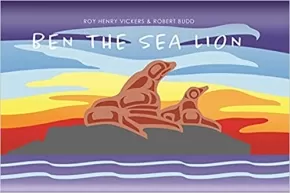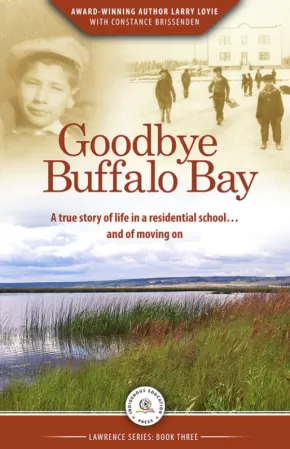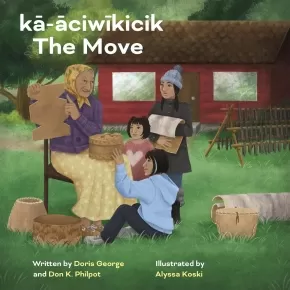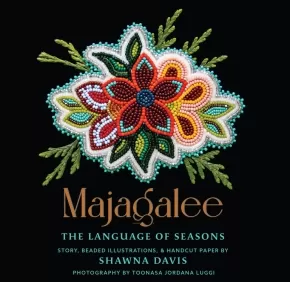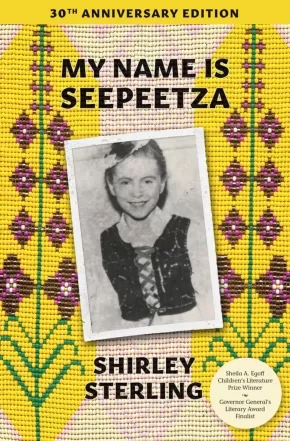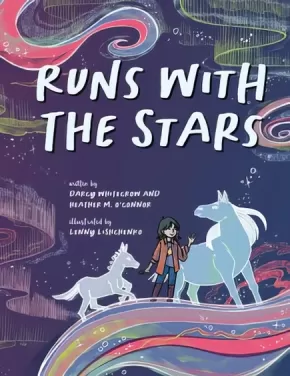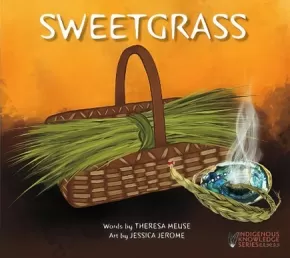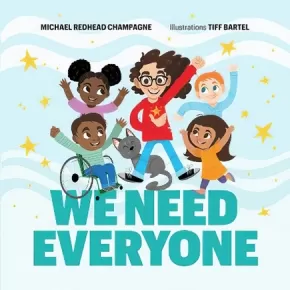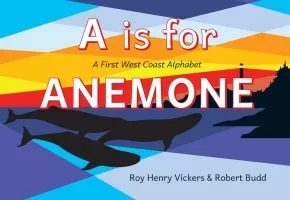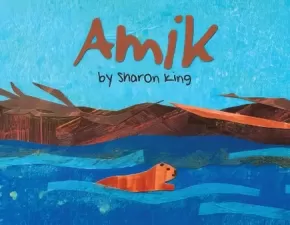
Canadian Indigenous Resource Lists
91
-
105
of
461 Results;
Sort By
Go To
of 31
Ben the Sea Lion
$22.95
Format:
Hardcover
Text Content Territories:
Indigenous Canadian; First Nations; Tsimshian (Ts'msysen);
Grade Levels: Preschool; Kindergarten;
ISBN / Barcode: 9781550179736
Synopsis:
Synopsis:
Tsimshian storyteller and artist Roy Henry Vickers shares an adventure from his childhood in the Indigenous village of Kitkatla, on BC’s north coast.
When Uncle Johnny accidentally catches an orphaned sea lion pup in his fishing net, young Roy and his cousin Bussy take responsibility for nursing the tiny creature back to health. They name the pup Ben, short for Teeben—the Tsimshian word for sea lion. With the boys’ loving care, Ben eats and eats and grows and grows, getting up to all sorts of fun in Kitkatla, including towing the boys in their skiff and showing local dogs who is boss! Eventually, Ben must return to the wild, leaving his human friends to remember him fondly.
Fifteen original illustrations by Roy Henry Vickers accompany the text, capturing the beauty of the West Coast and the richness of village life. Ben the Sea Lion will delight readers of all ages.
Educator Information
Recommended for ages 3 to 5.
Additional Information
32 pages | 12.00" x 8.25" | Hardcover
First Nations 101: Tons of Stuff You Need to Know - 2nd Edition
$23.00
Format:
Paperback
Text Content Territories:
Indigenous Canadian; First Nations;
ISBN / Barcode: 978-0-9869640-1-5
Synopsis:
Synopsis:
Updated and expanded 2nd edition of the national best seller!
First Nations 101 provides a broad overview of the day-to-day lives of Indigenous people, traditional Indigenous communities, colonial interventions used in an attempt to assimilate Indigenous people into mainstream society, the impacts those interventions had on Indigenous families and communities, and how Indigenous people are working towards holistic health and wellness today.
This 2nd edition has over 75 chapters, including new ones on rematriation, water for life, governance ‘options’, Indigenous feminisms, decolonization, (mis)appropriation, Indigenous Knowledge, and how to become a great ally.
Educator Information
Author Lynda Gray’s accessible writing style makes First Nations 101 the perfect primer for all to read. She notes that although governments may encourage and fund reconciliation activities, true reconciliation can only happen through the ongoing commitment and consistent actions of individuals, groups, organizations, governments, and businesses.
$1 from each book sold will be donated to the Ts’msyen Revolution Fund which Lynda Gray and her children, Dr. Robin Gray and artist Phil Gray, started in 2022. The Fund will help support Ts’msyen language and culture revitalization in laxyuubm Ts’msyen (Ts’msyen territory).
Lynda Gray is member of the Ts’msyen Nation from Lax Kw’alaams on the Northwest Coast of B.C. The book’s cover art was created by her son Phil Gray and features a 'neełx (killerwhale) to represent the author and her children’s clan (Gisbutwada).
The 2nd edition has over 75 chapters, with 16 new ones including rematriation, what is reconciliation, traditional economies, water for life, Indigenous feminisms, (mis)appropriation, economic development, Indigenous Knowledge, how to become a great ally, and more.
Additional Information
336 Pages | Updated and expanded 2nd edition
Goodbye Buffalo Bay
$19.99
Format:
Paperback
Text Content Territories:
Indigenous Canadian; First Nations; Cree (Nehiyawak);
ISBN / Barcode: 9781990297274
Synopsis:
Synopsis:
A true story of life in a residential school and of moving on. Written by Award-Winning Cree author Larry Loyie with Constance Brissenden.
Goodbye Buffalo Bay is set during the author's teenage years. In his last year in residential school, Lawrence learns the power of courage to stand up for his beliefs. When he returns home he feels like a stranger to his family. The traditional First Nations life he once knew has changed. With Grandfather's guidance he finds his way. A book of self-discovery and the importance of friendship.
Educator & Series Information
This book is part of The Lawrence Series.
Recommended for grades 4 to 9.
Additional Information
142 Pages | Paperback
kā-āciwīkicik / The Move (PB)
$14.95
Format:
Paperback
Text Content Territories:
Indigenous Canadian; First Nations; Cree (Nehiyawak); Swampy Cree ; Chemawawin First Nation ;
ISBN / Barcode: 9781772034288
Synopsis:
Synopsis:
A magical children’s picture book, written in Cree and English, depicting the transformation of a barren landscape into a rich natural world where an elderly couple can spend their remaining days.
Rooted in the historical displacement and relocation of members of the Chemawawin First Nation from their ancestral homeland, The Move is a bilingual story of two Cree Elders adjusting to life in their new environment. The story presents two contrasting landscapes of the old community—the homeland of the Chemawawin People—and the new community of Easterville, which at first appears barren and lifeless. Gradually, the couple begins to incorporate their old customs and traditions into their current surroundings. Family members begin to visit, and eventually nature begins to bloom all around them. Through traditional Cree storytelling techniques and vivid imagery, the new landscape springs to life and becomes a true community, filled with life and happiness.
Reviews
“kā-āciwīkicik / The Move is a small treasure. A wonderful story about memory, land, and kinship, and how language is integral to our relations with each other and with the land and all living things. This is a moving story of hope, wonderfully illustrated in tones that feel like earth, and with translation into Cree it invites us in, like a crackling fireplace in a log cabin, to sit with a cup of tea in hand and learn the old stories.” —Paul Seesequasis, bestselling author of Blanket Toss Under Midnight Sun
“My experience reading kā-āciwīkicik / The Move was profound. From the dreariness of relocation and searching for hope to finding happiness in reconnecting to culture—this story is both educational and poetic. Doris, Don and Alyssa balance healing in two worlds and do it beautifully through words, storyline, and graphics.” —Shayla Raine, author of The Way Creator Sees You
Educator Information
Recommended for ages 4 to 8.
Dual-Language: Cree and English.
Additional Information
48 pages | Paperback
Majagalee: The Language of Seasons
$22.00
Artists:
Format:
Hardcover
Text Content Territories:
Indigenous Canadian; First Nations; Gitxsan (Gitksan);
ISBN / Barcode: 9781990458002
Synopsis:
Synopsis:
Shawna Davis invites the reader to explore each of the four seasons through her beautiful words and lush, unforgettable, beaded illustrations.
We begin in Gwooyim (Spring) when the Majagalee, the Sim Algyax word for “flower,” are just beginning to sprout. We then move on to Sint (Summer) when Grandmother Sun stays in the sky a bit longer. Next there is Xwsit (Fall), just as Summer begins to get sleepy, and Maadim (Winter) where the snow has fallen and the freezer is full.
This is a story of nature, its importance to our lives, and why it must be cared for and respected.
Toonasa Jordana Luggi’s lovely, rich, and nearly tactile photographs are the perfect complement to Shawna’s hand-beaded artwork and wonderful, hand-cut paper backgrounds.
Includes Pronunciation Guides.
Reviews
“...simple, evocative poetry is culturally specific, rooted in a deep love of the land and the people around her but it’s also relatable to readers of different backgrounds. The lyrical verse in Majagalee makes it an ideal read-aloud book.... Majagalee is an elevated concept book. It introduces readers to the seasons, the plants and animals of the Northwest Coast, Sim Algyax, Indigenous art, and the importance of all these things to Gitksan culture. Despite its apparent simplicity, Majagalee is a complex and brilliantly constructed book. It will appeal to Indigenous and non-Indigenous readers alike, and for teachers and parents, it serves as an outstanding example of a book that demonstrates the ongoing presence and beauty of Indigenous cultures in what is now known as Canada..” – Quill & Quire, starred review
Educator Information
Juvenile Fiction. This picture book explores the four seasons on the northwest coast of what is currently British Columbia from a Gitksan perspective.
Additional information
Pages: 40
My Name is Seepeetza: 30th Anniversary Edition
$12.99
Format:
Paperback
Text Content Territories:
Indigenous Canadian; First Nations; Salish; Interior Salish; Nlaka'pamux (Thompson);
ISBN / Barcode: 9781773068565
Synopsis:
Synopsis:
An honest look at life in an Indian residential school in the 1950s, and how one indomitable young spirit survived it — 30th anniversary edition.
Seepeetza loves living on Joyaska Ranch with her family. But when she is six years old, she is driven to the town of Kalamak, in the interior of British Columbia. Seepeetza will spend the next several years of her life at an Indian residential school. The nuns call her Martha and cut her hair. Worst of all, she is forbidden to “talk Indian,” even with her sisters and cousins.
Still, Seepeetza looks for bright spots — the cookie she receives at Halloween, the dance practices. Most of all, there are her memories of holidays back at the ranch — camping trips, horseback riding, picking berries and cleaning fish with her mother, aunt and grandmother. Always, thoughts of home make school life bearable.
Based on her own experiences at the Kamloops Indian Residential School, this powerful novel by Nlaka’pamux author Shirley Sterling is a moving account of one of the most blatant expressions of racism in the history of Canada.
Includes a new afterword by acclaimed Cree author Tomson Highway of the Barren Lands First Nation in northern Manitoba.
Educator Information
Recommended for ages 9 to 12.
Key Text Features: afterword, dialogue, journal entries, maps.
Correlates to the Common Core State Standards in English Language Arts:
CCSS.ELA-LITERACY.RL.4.2
Determine a theme of a story, drama, or poem from details in the text; summarize the text.
CCSS.ELA-LITERACY.RL.5.1
Quote accurately from a text when explaining what the text says explicitly and when drawing inferences from the text.
CCSS.ELA-LITERACY.RL.6.6
Explain how an author develops the point of view of the narrator or speaker in a text.
Includes a new afterword by acclaimed Cree author Tomson Highway of the Barren Lands First Nation in northern Manitoba.
Additional Information
128 pages | 5.10" x 7.50"
nimosôm anima--nimihšōmihš ta-minciwēnciman: Grandfather's Reminder
$19.95
Artists:
Format:
Hardcover
Text Content Territories:
Indigenous Canadian; First Nations; Anishinaabeg; Ojibway; Saulteaux; Cree (Nehiyawak); Plains Cree;
Grade Levels: Kindergarten; 1;
ISBN / Barcode: 9781988783826
Synopsis:
Synopsis:
“We need to be careful that we don’t hurt the gifts that are given to us.” Told in Plains Cree, Saulteaux, and English, this simple tale of traditional teachings and values follows a grandparent and grandchild on a visit to a chokecherry patch, where lessons about respect and gratitude for the earth’s gifts are shared.
Educator Information
Recommended for ages 3+
Triple-language format: Plains Cree, Saulteaux, and English.
An afterword includes a Saulteaux and Plains Cree pronunciation guide.
Additional Information
40 pages | 11.00" x 8.50" | Hardcover
Runs with the Stars
$19.95
Artists:
Format:
Hardcover
Text Content Territories:
Indigenous Canadian; First Nations; Anishinaabeg; Ojibway;
ISBN / Barcode: 9781772602388
Synopsis:
Synopsis:
“Elders say they were always here. The horses were small, but strong.”
“Like me?”
“Like you.”
As they await the birth of a new foal, a man teaches his grandchild about the Ojibwe Horses that used to roam the forests of northwestern Ontario. The horses once ran wild and free, but when Grandfather was a boy, they almost disappeared. Now he is the caretaker of his own small herd, keeping the breed alive for future generations and teaching his grandchild about the loving bond between human and animals.
Educator Information
Recommended for ages 6 to 8.
This book is available in a dual-language format: Wiijibibamatoon Anangoonan/Runs with the Stars
Subjects: Character Education; Family & Friendship; History & Social Studies; Canadian History; First Nations & Indigenous Peoples; Science; Environmentalism; Conservation and stewardship; Reflecting Diversity
Additional Information
32 pages | 8.50" x 11.00" | Hardcover
Sweetgrass
$12.95
Artists:
Format:
Paperback
Text Content Territories:
Indigenous Canadian; First Nations; Mi'kmaq;
ISBN / Barcode: 9781771089333
Synopsis:
Synopsis:
A modern story of traditional Indigenous knowledge that follows a young boy and his Auntie as they gather and braid sweetgrass, one of the four sacred medicines.
It's early July, and for Matthew and his Auntie that means one thing: time to go sweetgrass picking. This year, Matthew's younger cousin Warren is coming along, and it will be his first time visiting the shoreline where the sweetgrass grows.
With Auntie's traditional Mi'kmaw knowledge and Matthew's gentle guidance, Warren learns about the many uses for sweetgrass—as traditional medicine, a sacred offering, a smudging ingredient—and the importance of not picking more than he needs. Once the trio is back at Auntie's house, she shows the boys how to clean and braid the grass.
From the duo behind the bestsellers The Gathering and The Sharing Circle, this heartfelt story about the gifts we receive from Mother Earth and how to gather them respectfully offers thoughtful insight into a treasured Mi'kmaw tradition.
Sweetgrass grows in wet meadows, low prairies, and the edges of sloughs and marshes. It grows from Labrador to Alaska, south to New Jersey, Indiana, Iowa, New Mexico, and Arizona. Widely used by North American Indigenous Peoples from many different Nations, it is also considered one of the "four sacred medicines" by many Plains Indians.
Educator & Series Information
Recommended for ages 4 to 7.
This book is part of the Indigenous Knowledge Series.
This book is available in French: Foin d'odeur
Additional Information
32 pages | 9.00" x 8.00" | Paperback
Swift Fox All Along (PB)
$10.99
Format:
Paperback
Text Content Territories:
Indigenous Canadian; First Nations; Mi'kmaq;
ISBN / Barcode: 9781773214474
Synopsis:
Synopsis:
What does it mean to be Mi’kmaq? And if Swift Fox can’t find the answer, will she ever feel like part of her family?
When Swift Fox’s father picks her up to go visit her aunties, uncles, and cousins, her belly is already full of butterflies. And when he tells her that today is the day that she’ll learn how to be Mi’kmaq, the butterflies grow even bigger. Though her father reassures her that Mi’kmaq is who she is from her eyes to her toes, Swift Fox doesn’t understand what that means. Her family welcomes her with smiles and hugs, but when it’s time to smudge and everyone else knows how, Swift Fox feels even more like she doesn’t belong.
Then she meets her cousin Sully and realizes that she’s not the only one who’s unsure—and she may even be the one to teach him something about what being Mi’kmaq means. Based on the author’s own experience, with striking illustrations by Maya McKibbin, Swift Fox All Along is a poignant story about identity and belonging that is at once personal and universally resonant.
Reviews
“A touching and universal narrative . . . This title should definitely be added to any list of recommended children’s books focused on Indigenous life, family, tradition, feelings, anxiety, fear and self-regulation. Swift Fox All Along is also brimming with cross-curricular applications for school use, including incorporation with science, social studies, history, language, and mental health. Highly Recommended.” — CM Reviews
“Highlights the importance of connections to culture and self.” — Kirkus Reviews, 07/28/20
"This is a straightforward tale of a girl finding her way into a culture that is her heritage, yet new to her. As such, it works effectively. This may suit libraries in need of more modern Native picture books with child appeal.” — School Library Journal, 08/20
Educator Information
Recommended for ages 4 to 7.
Own voices: Illustrator Maya McKibbin is a two-spirited Yaqui, Ojibwe and Irish. Author Rebecca Thomas is an award-winning Mi’kmaw poet. The story is deeply personal. Rebecca is of mixed heritage and grew up off-reserve and was 6 years old before she began getting to know her father. Her dad himself attended a residential school and had lost connection with his culture and language. This was something regained later with wider visits to his home community and wanted to share with his children.
Important themes: the Indigenous story is full of universal themes including family, connection, identity and self-acceptance.
This book is available in French: Wowgwis de la tête aux pieds
Additional Information
36 pages | 9.00" x 10.25" | Paperback
Una Huna?: Ukpik Learns to Sew (HC)
$18.95
Artists:
Format:
Hardcover
Text Content Territories:
Indigenous Canadian; Inuit;
ISBN / Barcode: 9781772274332
Synopsis:
Synopsis:
Ukpik’s mother is eager to teach Ukpik how to prepare caribou skin, dry it, and use it to sew a pair of simple, useful mitts. But Ukpik can’t stop thinking about the beautiful new beads her mother traded the Captain for on his last visit. They are so bright and beautiful! Anaana knows it is more important for Ukpik to learn the skills she will need to make her own clothing in the cold Arctic climate, so she insists that Ukpik sit with her and learn the basics, while having a bit of fun, too. Though Anaana won’t let Ukpik sew with the new beads just yet, she does have a surprise for Ukpik that will let her enjoy the new-found treasures while also learning the skills she will need to provide for herself and her family.
Educator Information
Recommended for ages 6 to 8.
Additional Information
36 pages | 8.00" x 9.00" | Hardcover
We Need Everyone
$21.95
Artists:
Format:
Hardcover
ISBN / Barcode: 9781774920114
Synopsis:
Synopsis:
Everyone has a gift. Every gift is different, and every gift is special. Our world needs you to share your gift.
What is your gift? How can you use your gift to help others?
We Need Everyone empowers children to identify their gifts and use them to overcome challenges, achieve goals, and strengthen communities. Inspiring and uplifting, this interactive picture book celebrates diverse cultures, perspectives, and abilities through playful illustrations. Perfect for reading aloud.
Reviews
"We Need Everyone is populated by kids of all different shapes, sizes and skin tones, with different abilities and, of course, different interests and gifts. It’s as the title says: a strong, healthy, vibrant community needs everyone."— Winnipeg Free Press
"We Need Everyone echoes a universal truth: we are in this world to be supportive and respectful of each other's gifts and talents. Michael's love for and commitment to this powerful idea is revealed on every page." —Fred Penner, Juno Award-winning entertainer
"We Need Everyone is a book that has been needed for a long time! This book shows us why it is important to look for what people can bring to a community, rather than what they are missing or need to change. It also reminds us that every single one of us has something to offer, exactly as we are." —Shelley Moore, author of One Without the Other
"We Need Everyone is a book that has been needed for a long time! This book shows us why it is important to look for what people can bring to a community, rather than what they are missing or need to change. It also reminds us that every single one of us has something to offer, exactly as we are." —Shelley Moore, author of One Without the Other
Educator Information
Recommended for ages 6 to 8.
Michael Redhead Champagne’s welcoming call to action will inspire young readers to contribute to their communities by recognizing their own gifts and talents.
Recommended in the Indigenous Books for Schools catalogue as a valuable resource for English Language Arts, Social Studies, and Career Education in grades 1 to 3.
Themes: Diversity, Identity, Interconnectedness, Relationships, Social Justice.
Additional Information
40 pages | 9.00" x 9.00" | Hardcover
FLASH SALE! A is for Anemone (BB)
$11.22 $14.95
Format:
Board Book
Text Content Territories:
Indigenous Canadian;
Grade Levels: Preschool;
ISBN / Barcode: 9781550179477
Synopsis:
Synopsis:
With crisp, luminous illustrations by celebrated Indigenous artist Roy Henry Vickers, and a simple rythmic text, this sturdy board book introduces the alphabet using iconic imagery of the West Coast, creating a book that will be cherished by young readers and their families.
Starting with colourful sea anemones waving in the ocean current, and closing with a snoozing grizzly bear (Zzz), this board book supports both early literacy and children's awareness of the natural world.
Publishers Weekly described Vicker’s previous collaboration with Robert Budd as “a gorgeous glimpse of the distinctive landscapes and creatures of the Northwest, [that] will enchant residents and nonlocals alike.”
Educator & Series Information
This book is a part of the First West Coast Books series.
Recommended for ages 3 and under.
Key Topics / Concepts: ABCs, Alphabet, West Coast, Indigenous, Canadian, Earth Sciences, Water, Literacy Development, Early Learners, Indigenous Artwork.
Additional Information
28 pages | 7.25" x 5.00" | Boardbook
Amik (BB)
$15.00
Artists:
Format:
Board Book
Text Content Territories:
Indigenous Canadian; First Nations; Anishinaabeg; Potawatomi;
ISBN / Barcode: 9781928120285
Synopsis:
Synopsis:
The beaver is busy...
This delightful children's picture book tells the story of amik, the beaver, who works on his dam throughout the day while nature and the activities of other animals carry on around him. At the end of a long day, amik returns to his den to be with his family.
Along with its beautiful cut-paper illustrations, Amik offers the chance for children to learn words and phrases in the Ojibwe language, as the text appears in both English and Anishinaabemowin. A fun, colourful and engaging book for children ages three through six.
Educator Information
Recommended for ages 3 to 6.
Dual-language: English and Anishinaabemowin
Additional Information
20 pages | 9.00" x 8.00" | Board Book
Animals Illustrated: Wolverine
$15.95
Artists:
Format:
Hardcover
Text Content Territories:
Indigenous Canadian; Inuit;
ISBN / Barcode: 9781772272987
Synopsis:
Synopsis:
In this book, kids will learn how wolverines raise their babies, where they live, what they eat, and other interesting information, like how they use their distinctive scent and how they became known as the gluttons of the animal kingdom!
Reviews
"Niptanatiak shares the scientific facts about the animal in a very accessible and simple way, so despite its factual nature this book feels like anything but a boring textbook. A key focus of the facts is how the wolverine engages with its surroundings and other animals, making it a great way to introduce young readers to the Indigenous concept of relationality." - Excerpt from IBBY Canada's From Sea to Sea to Sea: Celebrating Indigenous Picture Books - 2023 Edition
Educator & Series Information
This book is part of the non-fiction Animals Illustrated series, which mixes fun-filled animal facts suitable for the youngest of readers with intricately detailed illustrations to create a unique and beautiful collection of children’s non-fiction books on Arctic animals. Each volume contains firsthand accounts from authors who live in the Arctic, along with interesting facts on the behaviours and biology of each animal.
Themes: Nunavut, Inuit, Indigenous, Arctic Animals, STEM
"A key focus of the facts is how the wolverine engages with its surroundings and other animals, making it a great way to introduce young readers to the Indigenous concept of relationality" - From Sea to Sea to Sea 2023 Edition
Recommended Ages: 6 to 8.
Available in French: Carcajou
Additional Information
28 pages | 6.50" x 9.00" | Hardcover
Sort By
Go To
of 31

